Chapter: Mathematics (maths) : Boundary Value Problems In Ordinary And Partial Differential Equations
Boundary Value Problems In Ordinary And Partial Differential Equations
Boundary value Problems in ODE&PDE
BOUNDARY
VALUE PROBLEMS IN ODE & PDE
1
Solution of Boundary Value Problems in ODE
2
Solution of Laplace Equation and Poisson Equation
Solution of Laplace Equation – Leibmann`s iteration
process
Solution of Poisson Equation
3
Solution of One Dimensional Heat Equation
Bender-Schmidt Method
Crank- Nicholson Method
4
Solution of One Dimensional Wave Equation
1 Solution of Boundary
value problems in ODE
Introduction
The solution of a
differential equation of second order of the form F (x, y,
y’ , y’’ ) 0 contains
two arbitrary constants. These constants are determined by means of two
conditions. The conditions on y and y’or their combination are prescribed at two different values of x
are called boundary conditions.
The differential
equation together with the boundary conditions is called a boundary value
problem.
In this chapter ,we
consider the finite difference method of solving linear boundary value problems
of the form.
Finite difference approximations to derivatives
First derivative approximations

Second derivative approximations

Third derivative approximations

Fourth derivative
approximations

Solution of ordinary differential
equations of Second order
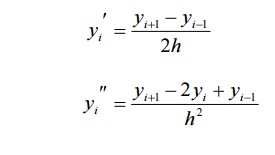
Problems

Sol:
(i)
Divide the interval[1,2] into two
sub-intervals with h=(2-1)/2=0.5
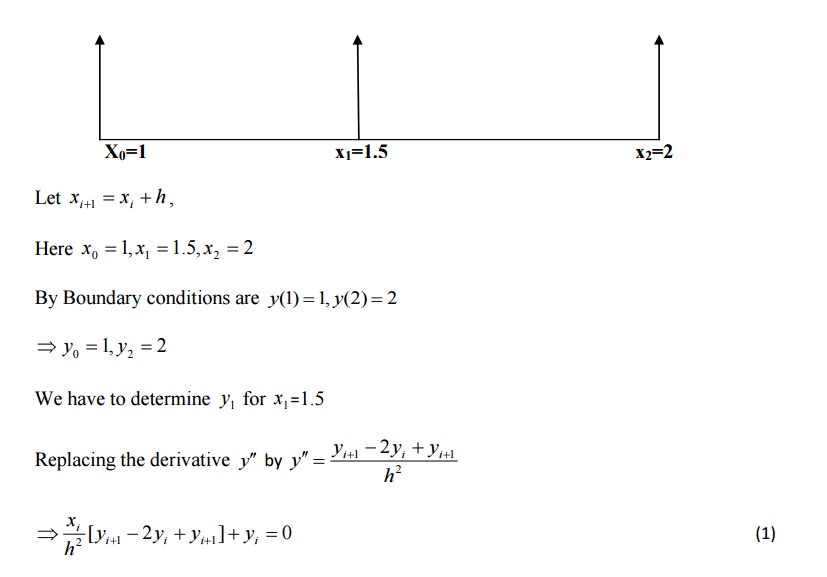
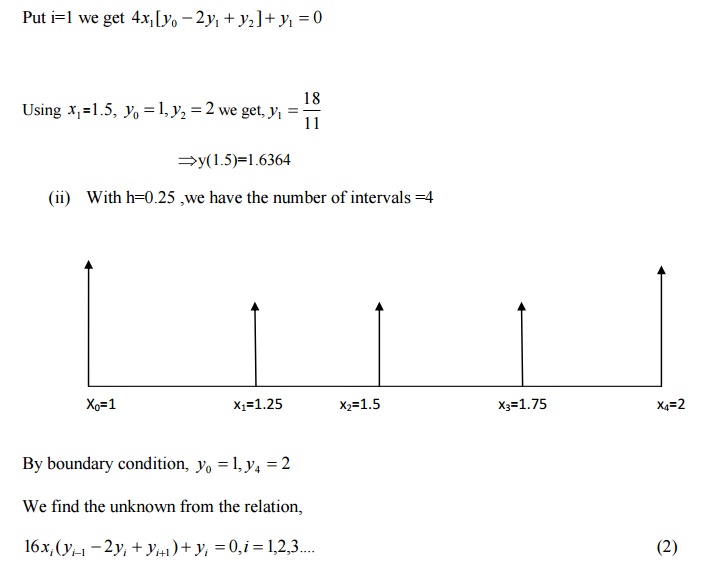
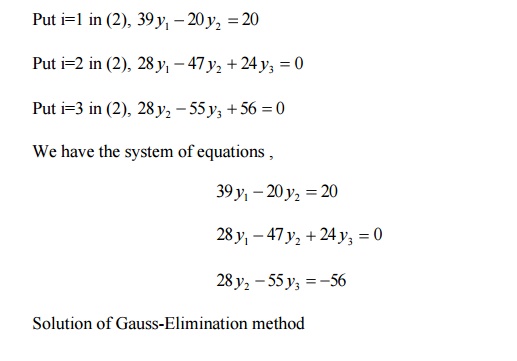
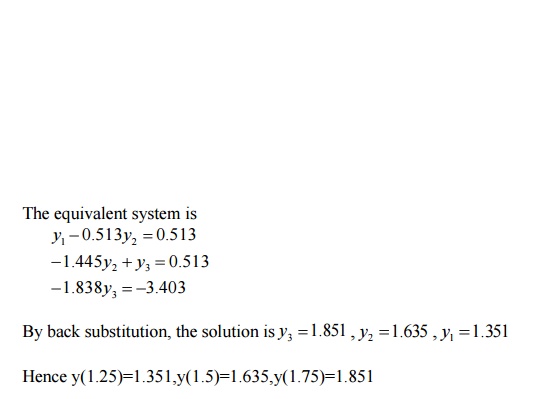

2 Solution of
Laplace Equation and Poisson equation
Partial differential
equations with boundary conditions can be solved in a region by replacing the
partial derivative by their finite difference approximations. The finite
difference approximations to partial derivatives at a point (xi,yi)
are given below. The xy-plane is divided
into a network of rectangle of lengh ∆x= h and breadth ∆y=k
by drawing the lines x=ih and y=jk, parallel to x and y axes.The points
of intersection of these lines are called grid points or mesh points or lattics
points.The grid points ( xi , y j )
is denoted by (i,j) and is surrounded by the neighbouring grid points
(i-1,j),(i+1,j),(i,j-1),(i,j+1) etc.,
Note
The most general linear
P.D.E of second order can be written as

Where A,B,C,D,E,F are in general functions of x and
y.
The equation (1) is said
to be
Elliptic if B2-4AC<0
Parabolic if B2-4AC=0
Hyperbolic if B2-4AC>0
Solution of
Laplace equation uxx+uyy=0

This formula is called Standard
five point formula

Leibmann’s
Iteration Process

We compute u1
,u3 ,u7 .u9 by using diagonal five point formula (DFPF)
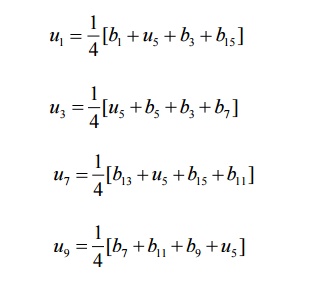
Finally we compute u2
,u4 ,u6 ,u8 by using standard five point formula.
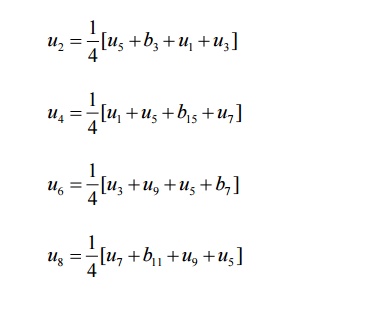
The use of Gauss-seidel iteration method to solve
the system of equations obtained by finite difference method is called Leibmann’s
method.
Problems
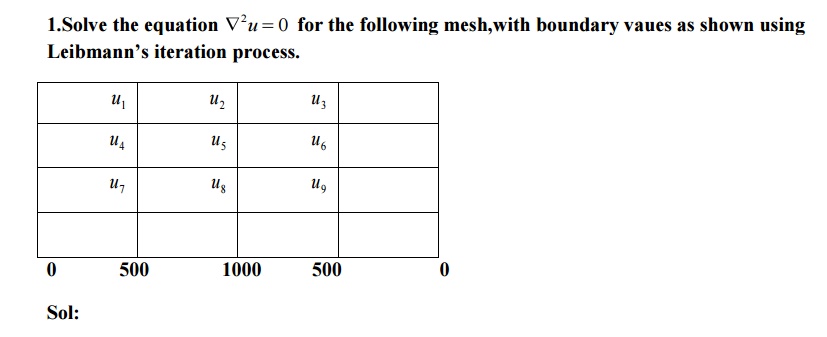
Sol:
Let u1
,
u2
……u9
be the
values of u at the interior mesh points of the given region.By symmetry about
the lines
AB and the line CD,we observe

Hence it is enough to find u1 , u2 , u4 , u5
Calculation of
rough values
u5
=1500
u1
=1125
u2
=1187.5
u4
=1437.5
Gauss-seidel scheme
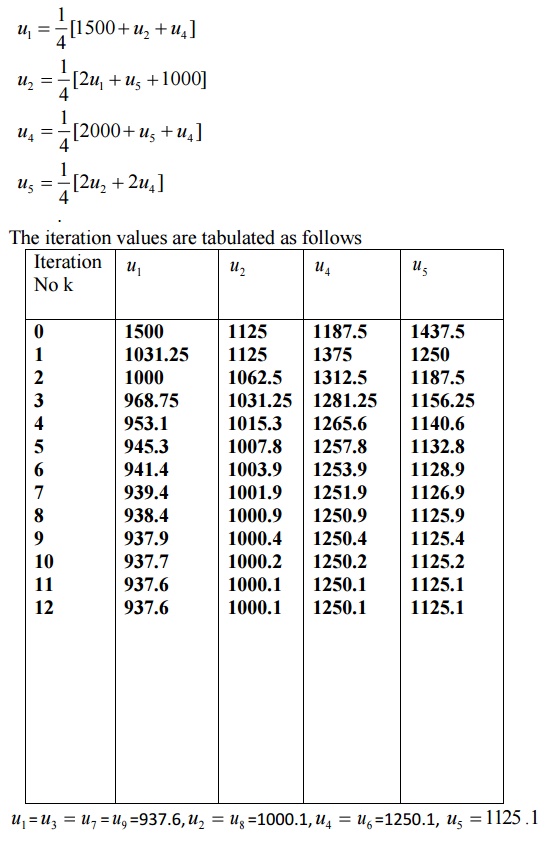
2.When steady state
condition prevail,the temperature distribution of the plate is represented by
Laplace equation uxx+uyy=0.The temperature along the
edges of the square plate of side 4 are given by along x=y=0,u=x3
along y=4 and u=16y along x=4,divide the square plate into 16 square meshes of
side h=1 ,compute the temperature a iteration process.
Solution of
Poisson equation

This expression is
called the replacement formula.applying this equation at each internal mesh
point ,we get a system of linear equations in ui,where ui
are the values of u at the internal mesh points.Solving the equations,the
values ui are known.
Problems
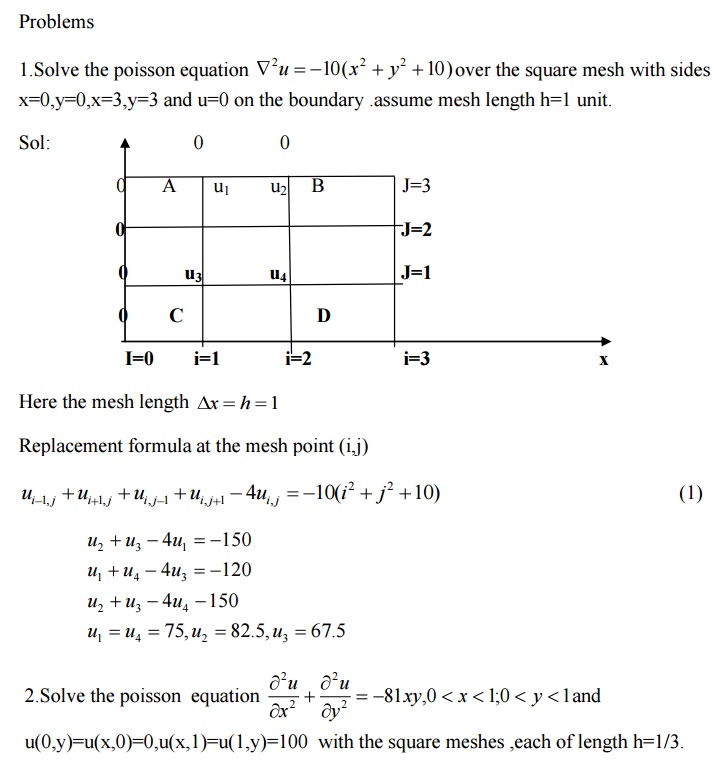
u(0,y)=u(x,0)=0,u(x,1)=u(1,y)=100
with the square meshes ,each of length h=1/3.
3 Solution of One dimensional heat equation
In this session, we
will discuss the finite difference solution of one dimensional heat flow equation
by Explicit and implicit method
Explicit
Method(Bender-Schmidt method
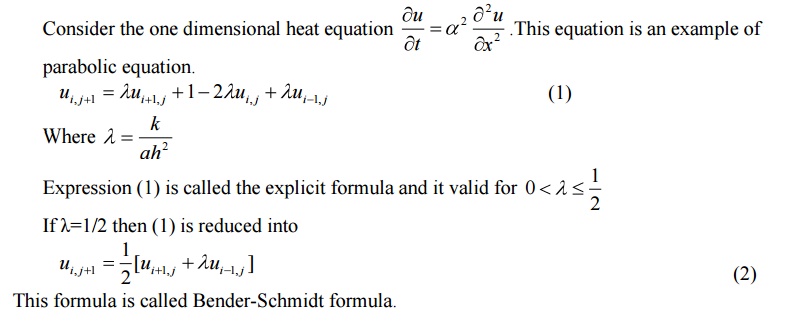
This formula is called
Bender-Schmidt formula.
Implicit method
(Crank-Nicholson method)

This expression is called Crank-Nicholson’s implicit scheme.
This expression is called Crank-Nicholson’s implicit scheme. We note that Crank Nicholson’s scheme converges for all values of λ

The use of the above
simplest scheme is given below.

The value of u at A=Average of the values of u at B,
C, D, E
Note
In this scheme, the
values of u at a time step are obtained by solving a system of linear equations
in the unknowns ui.
Solved Examples when u(0,t)=0,u(4,t)=0
and with initial condition u(x,0)=x(4-x) upto t=sec
1.Solve u xx = 2ut assuming ∆x=h=1
Sol:
By Bender-Schmidt
recurrence relation ,

For applying eqn(1) ,we
choose
Here a=2,h=1.Then k=1
By initial conditions,
u(x,0)=x(4-x) ,we have

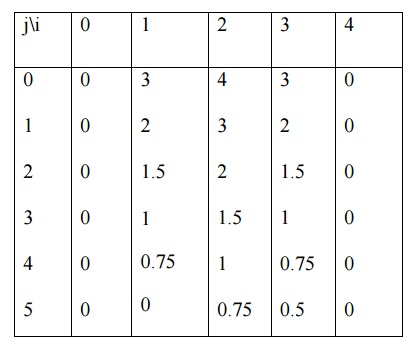
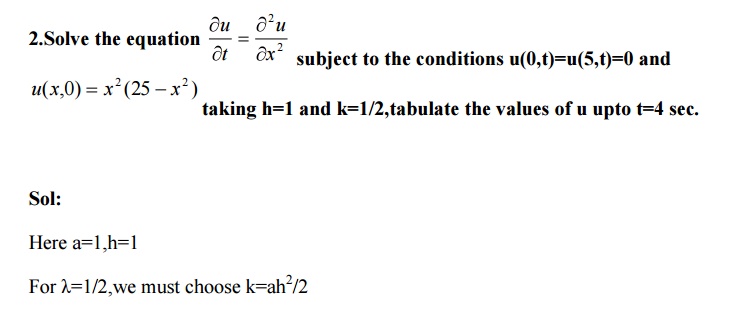
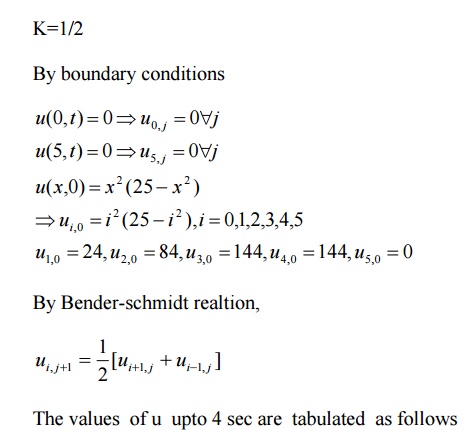
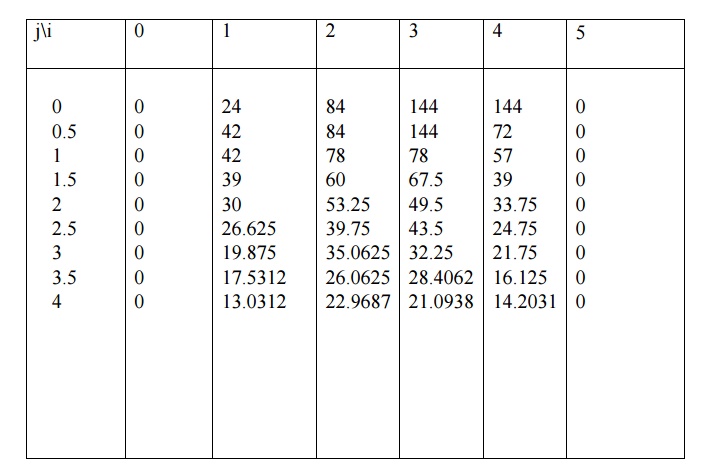
4 Solution of One dimensional wave
equation
Introduction
The one dimensional
wave equation is of hyperbolic type. In this session, we discuss the finite difference solution of the one dimensional wave equation

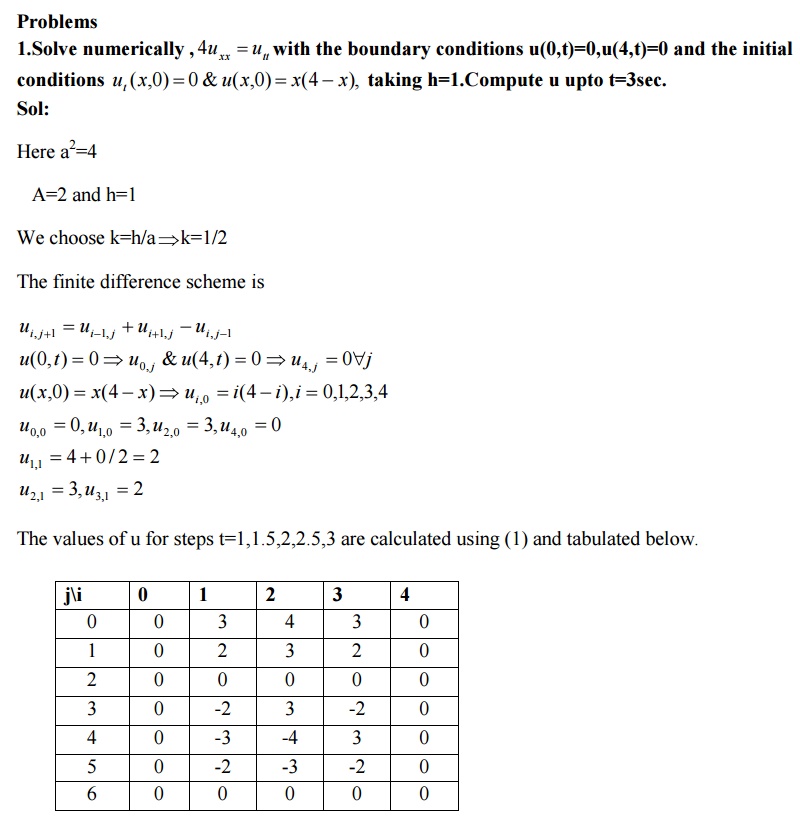

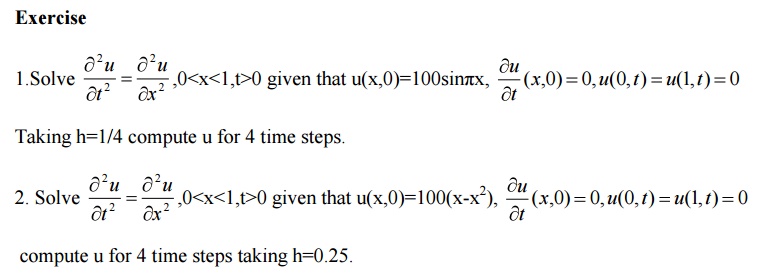

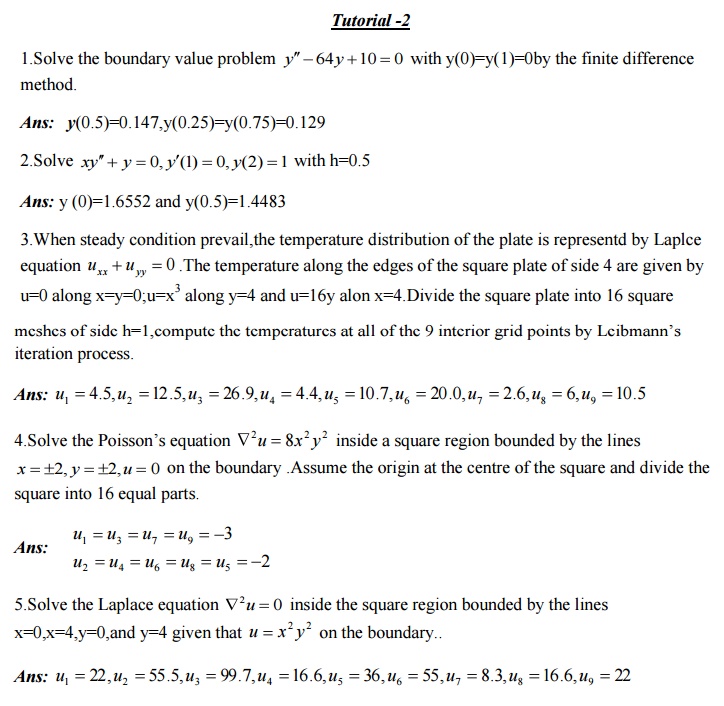
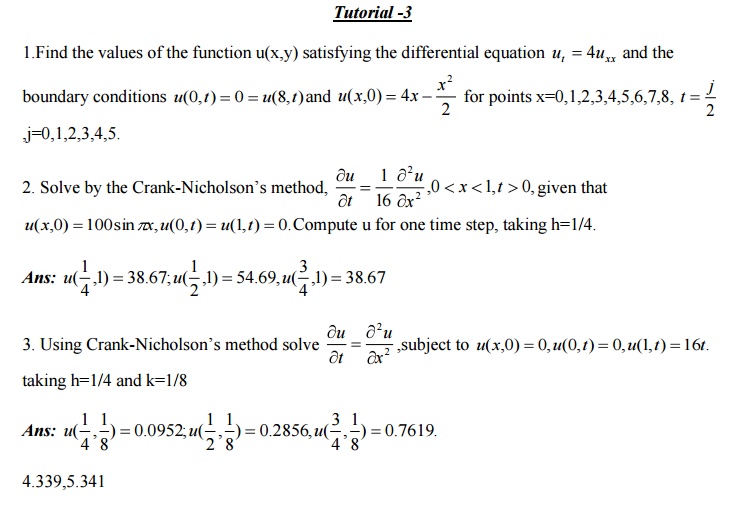
Part
A
1.What
is the error for solving Laplace and Poisson’s equations by finite difference
method?
Sol:
The error in replacing
by the difference expression is of the order . Since h=k, the error in replaing
by the difference expression is of the order .
![]()
![]()
2. Define a
difference quotient.
Sol:
A difference quotient
is the quotient obtained by dividing the difference between two values of a
function by the difference between two corresponding values of the independent
variable.
3.
Why is Crank Nicholson’s scheme called
an implicit scheme?
Sol:
The Schematic
representation of crank Nicholson method is shown below.
The solution value at
any point (i,j+1) on the (j +1)th level is dependent
on the solution values at the neighboring points on the same level and on three
values on the j th level. Hence it is an implicit
method.
4. What are the methods to solve second
order boundary-value problems?
Sol:
(i)Finite difference method (ii)Shooting method.
5. What is the classification of one
dimensional heat flow equation.
Sol:
One dimensional heat
flow equation is

Here
A=1,B=0,C=0
B2
−4AC
= 0
Hence
the one dimensional heat flow equation is parabolic.
6. 6. State Schmidt’s explicit formula for solving heat flow equation
Sol: ---- ----
7. Write an explicit formula to solve numerically the heat equation (parabolic equation)
Sol:
--------- ----------
x and k is the space in the time direction).
The above formula is a
relation between the function values at the two levels j+1 and j and is called
a two level formula. The solution value at any point (i,j+1) on the (j+1)th
level is expressed in terms of the solution values at the points (i-1,j),(i,j)
and (i+1,j) on the j th level.Such a method is called explicit formula. the
formula is geometrically represented below.
8. State the
condition for the equation to be
(i)
elliptic,(ii)parabolic(iii)hyperbolic when A,B,C are functions of x
and y
Sol:
The
equation is elliptic if (2B2 ) −4AC < 0
(i.e) B2 −AC < 0. It is
parabolic if B2 −AC = 0 and hyperbolic if B2−4AC
> 0
9. Write a note on the stability and convergence
of the solution of the difference
equation corresponding to the hyperbolic
equation .
Sol:
For ,λ= the solution of
the difference equation is stable and coincides with the solution of the
differential equation. For λ> ,the solution is unstable.
![]()
![]()
For λ<
,the solution is stable but not convergent.
![]()
10. State
the explicit scheme formula for the solution of the wave equation.
Sol:
The formula to solve
numerically the wave equation =0 is
The schematic representation is shown below.
The solution value at
any point (i,j+1) on the ( j +1)th level is expressed in
terms of solution values on the previous j and (j-1) levels (and not interms of
values on the same level).Hence this is an explicit difference formula.
Related Topics